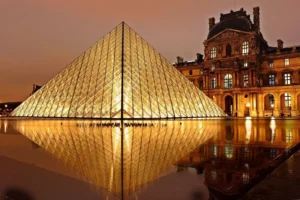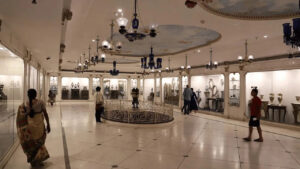
Blogs
The World’s Most-Visited Museums in 2024
Museums across the globe continue to captivate millions of visitors annually, offering a blend of art, history, technology, and cultural narratives. In 2024, the world’s most-visited museums embraced innovation to provide immersive experiences. This article dives deeper into their key exhibits, unique attractions, and the features that set them apart.
1. The Louvre Museum, Paris, France
- Visitor Count: Approximately 8.9 million visitors in 2024.
- Key Attractions:
- The Mona Lisa: The enigmatic smile of Leonardo da Vinci’s masterpiece continues to be the Louvre’s most iconic attraction. A new holographic projection surrounding the artwork offers visitors a deeper dive into the painting’s history and theories.
- The Winged Victory of Samothrace: This ancient Greek sculpture is displayed with enhanced lighting design, creating a dramatic and awe-inspiring presentation.
- Tech-Experiential Tours: Interactive AI-powered exhibits allow visitors to explore the Louvre’s vast collections virtually, making the experience accessible even to those unable to visit specific sections physically.
2. Vatican Museums, Vatican City
- Visitor Count: Around 6.8 million visitors.
- Key Attractions:
- The Sistine Chapel: Michelangelo’s breathtaking ceiling frescoes remain the highlight. In 2024, the Vatican introduced augmented reality (AR) experiences to provide detailed explanations of the artwork.
- Raphael Rooms: These rooms, adorned with frescoes by Raphael, now feature interactive kiosks offering insights into the artist’s techniques and inspirations.
- Historical Artifacts: The museum’s extensive collection of religious and historical artifacts is enhanced with holobox displays, offering 3D views of delicate objects.

3. National Museum of China, Beijing, China
- Visitor Count: Approximately 6.8 million visitors.
- Key Attractions:
- Ancient Chinese History Galleries: From the Terracotta Warriors to ancient manuscripts, this museum houses treasures that narrate China’s rich history.
- AI-Powered Exhibits: Visitors can engage with AI face projecting installations that allow them to virtually try on traditional Chinese attire or step into historical scenes.
- Interactive VR Games: Immersive VR experiences transport visitors to iconic historical events, such as the building of the Great Wall.
4. Metropolitan Museum of Art (The Met), New York, USA
- Visitor Count: Over 6 million visitors.
- Key Attractions:
- Egyptian Artifacts: The Temple of Dendur is an architectural marvel, now accompanied by AR overlays that reconstruct its original surroundings.
- Contemporary Art Wing: This section has been redesigned with interactive LED walls that display evolving artistic themes.
- The Costume Institute: Known for its annual Met Gala, this exhibit highlights fashion history with holographic runway displays and AI-powered exhibits exploring fabric technologies.
5. British Museum, London, UK
- Visitor Count: Approximately 5.9 million visitors.
- Key Attractions:
- The Rosetta Stone: Visitors can now use interactive installations to decipher the inscriptions, learning how the stone unlocked ancient Egyptian scripts.
- Ancient Greek and Roman Galleries: The museum has integrated holographic storytelling to depict myths and legends surrounding these civilizations.
- Digital Experience Center: A new wing equipped with AI and robotics showcases artifacts with digital recreations of their historical contexts.
Key Factors Driving Museum Attendance in 2024
The success of these museums can be attributed to their commitment to creating visitor-centered experiences:
- Innovative Digital Experiences: The integration of virtual reality (VR), augmented reality (AR), and AI-powered exhibits creates unique and engaging interactions.
- Spatial Experiences and Accessibility: Thoughtfully designed interiors and layouts improve flow and accessibility for all visitors.
- Thematic Exhibitions: Museums are increasingly curating their galleries to tell cohesive and compelling stories.
- Interactive Installations: Features such as interactive LED walls and holographic displays ensure that visitors are not mere spectators but active participants.

Design and Technological Trends in Museums
Museums are embracing technology and engineering advancements to enhance their spaces:
- AI and Automation: Museums are using AI for personalized tours and automation for crowd management.
- Lighting Design: Adaptive lighting systems are being employed to highlight artifacts and create ambiance.
- Interactive VR Games and AR Experiences: These technologies allow visitors to explore new dimensions of museum exhibits.
Interior Design and Architecture in Modern Museums
- Ergonomic Furniture Design: Comfortable seating and innovative display units ensure prolonged visitor engagement.
- Wayfinding and Signage: Intuitive navigation tools make museum visits stress-free and enjoyable.
- Landscape Integration: Museums are incorporating green spaces and outdoor exhibits to enhance the visitor experience.

How Peach Prime Consultancy Can Help
Peach Prime Consultancy specializes in designing and planning innovative museum spaces. Here’s how we can assist:
- Master Planning and Conceptualization: From initial ideas to fully realized plans, we ensure that your museum aligns with its vision and audience.
- Exhibit Design and Curation: We create interactive, thematic exhibitions that captivate and educate visitors.
- Technological Integration: Our team integrates cutting-edge technologies like AI, VR, and holographic displays to create immersive exhibits.
- Interior Architecture and Spatial Planning: We design spaces that are functional, aesthetically pleasing, and inclusive.
- Collaborative Approach: Our multidisciplinary team of designers, architects, and engineers works together to bring innovative museum concepts to life.
- Our services include comprehensive budget planning and cost estimation to ensure your project aligns with financial expectations, with a detailed breakdown of the total project cost.
The most-visited museums in 2024 demonstrate the power of blending art, history, and technology to create unforgettable visitor experiences. By focusing on interactive and immersive design, these institutions have set benchmarks for others to follow. Whether in Eilat, Amman, Zarqa, Irbid, Aqaba, Mafraq, Kuwait City, Al Jahra, Salmiya, Hawally, Fahaheel, Beirut, Tripoli, Sidon, Tyre, Baalbek, Muscat, Salalah, Sohar, Sur, Nizwa, East Jerusalem, Gaza City, Ramallah, Hebron, Bethlehem, Doha, Al Wakrah, Al Khor, Al Rayyan, Dukhan, Riyadh, Jeddah, Mecca, Medina, Dammam, Damascus, Aleppo, Homs, Latakia, Deir ez-Zor, Ankara, Istanbul, Izmir, Bursa, Antalya, London, New York, Beijing, Vatican City, Abu Dhabi, Dubai, Sharjah, Ajman, Al Ain, Sana’a, Aden, Taiz, Al Hudaydah, or Paris, these museums inspire visitors and continue to set high standards. Peach Prime Consultancy is proud to support the evolution of museums, offering expertise to create spaces that educate, inspire, and captivate.











